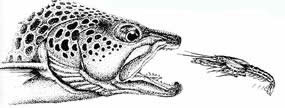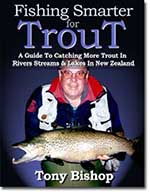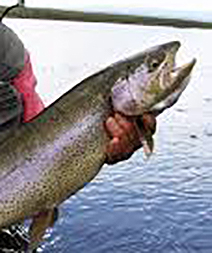


I think I have followed just about every road in my search for a big brown trout. Well that is not quite correct, I have found big brown trout, but catching the brutes, now there is a matter that stirs recollection of lost chances.
Still I suppose that waiting and fish are an inseparable couple.
It took me forty years to the day of catching my first fly rod trout to finally land a 4.5kg (10lb) rainbow. It was then way past forty years of catching browns, and still the big 10 benchmark fish would not succumb to my temptations.
Well, and again, not quite true.
Regularly my temptations proved very enticing indeed. Hooking big browns and landing them, now there is plenty of room for slips between cup and lip. There are too many slips in this big brown trout chasing career to bear much examination if any notion of my being at least a part way competent fisherman is to be retained.
The list of self-induced disasters is long.
Standing on loose coils of line is a well-practiced catastrophe. A loose coil of line wrapped around the reel proved a good standby when my feet for once were out of the line of fire. Over-excitement at the sight of a big fish in the shallows and the mad panic to land it usually guaranteed a hook pull or leader failure. Going on down the list would fill this page and more.
Still these little moments of silliness did teach me something.
No amount of obscenity-tossing at the tail of a retreating fish will make it turn from its chosen course.
In the Central North Island of New Zealand, many brown trout are not the fish of the crystal-clear streams of the South Island. Down South they are skittish creatures that bolt at the flicker of an angler's eye-lash. Trout that can only be tempted by tiny flies tossed by an angler with a University Degree in stealth. Trout that once hooked, flash and slash across the water, in their frantic efforts to escape.
In the North, browns often reach almost mythical status; creatures of deep dark pools, or denizens of the night. Most in the North will fish for browns in the dark, at night, or deep into black pools.
Fish that if hooked, dog down deep using slow, steady, brute force to out-muscle their foe. (This is not true of water in harder to reach places, and river headwaters; here big browns of the North act just like their South Island Cousins.)
Some brown addicts will seek their prey in summer, in the late hot afternoon, along a lake's edge. Sometimes fish can be spotted and fished to as they cruise along the weed beds near shore, feasting on tiny tidbits or koura (NZ freshwater crayfish). Others will fish the streams and rivers over summer, stalking the fish in mimic of their southern brothers.
Yes there are browns in the Central North Island in crystal clear headwaters, big brutes too, but the skill required to fish these fish is set at a fairly high level. And reaching these waters is either arduous or costly. Too hard for most, many northern browns are hooked by anglers fishing for their more colourful cousins.
(Article continues below advertisement)
In January through to March browns will migrate from the dark depths and congregate near stream and river mouths feasting on smelt, nymphs, floating insects, and small rainbow trout, bloating themselves to build for the rigors of spawning from March through till around July (Autumn through our Winter).
They wait for whatever signal pushes their buttons, and then fat and heavy off up the river they go.

Fish that move in the night, usually late at night. On calm summer nights browns often betray their presence by sound.
Out there in the blackness a large thumping 'splosh', like someone has thrown a brick in the water, is a good clue. The guys in the 'rip' (the current formed where a stream or river flows into a lake) will tell you, and they certainly tell each other, "big rainbow out there smelting." But that is a different sound, more of a splash than a 'splosh'.
Another sound that testifies to the presence of browns is a kind of slurping thump. The sound a cup makes when it is pulled under water with the opening to the top of the water.
Anglers can be given clues to the presence of browns by touch.
Those fishing well to the side of the rip will report "a touch". A plucking touch, the merest tiny pull on the fly, sometimes one or two little touches in quick succession, and then nothing.
Sometimes the pluck turns into a dead stop on the line and the rainbow trained angler rears back on the rod to set the hook, the rod bucks, comes up solid against a trembling taunt line, and then nothing. Usually no hook or leader. Brownies are about!
And so they were, just three days ago. Three days preceded by five days of clear blue skies and temperatures in the mid-twenties. Hot enough to warm the lake shore water. Tepid enough to attract shoals of smelt. Warm enough to fill the evening air with swarms of moths and cicadas.
As darkness fell the cool water in the centre of the lake pulled in the outlying air setting up a strong off-shore wind. A wind that concentrated moths and cicadas, and smelt at the far reaches of the current from the rip. The night was moonless black. Perfect lake brown-trout fishing conditions.
At half-ten I wandered down to the rip and watched the eight or nine anglers across the rip catching a few rainbows, and then encouraged by the "big rainbows smelting way out" I wandered down the lake edge for 70 or more metres.
(Article continues below advertisement)
I waded out to where Big John was standing. John is the only name I know for this man I have fished alongside many times, but never in light strong enough to recognize him in the daytime.
You have to be careful wading out to near John, he is a big lad
indeed, a lot nearer 7 foot than 6. Water can get pretty deep, pretty
damn quick, near Big John.![]()
A longish cast, the off-shore wind helped, dropped the tandem flies of a silicone smelt with a luminous core, followed by my secret fly, near the very tail of the rip, where it was joined by a back current generated by the rip.
For a half-hour or more it was lake fishing as usual; cast, slowly retrieve and little else. A couple of thin rainbows still 'mending' after the rigors of spawning came and went back. Then around a bit past eleven the 'sploshing' started, and one or two plucks confirmed some impending action. It did not take long.
My line cast out, and only one or two pulls into the retrieve I felt a little pluck, another, and then things got solid. I waded the long careful backward wade to the beach followed by the docile but heavy fish. Nearing the beach the fish decided enough was enough and took off back to the deeper water. The loping run, hard along the lakebed, signaled a good brown.
Eventually he turned, and a couple or three shorter runs I had him flopping on the beach. Beautiful big brown fish.
Good enough to break my curse I excitedly thought.
(Article continues below advertisement)
The scales proved otherwise, 'just' eight and a bit pound, but still my biggest brown to-date, so back he went. A very good fish, but not yet my ten-pound brown bogey broken.
The next night I was on the lake same time, same place. This time I had much more company. Five or six anglers lined up around me, not counting the eight or nine in the rip. Word travels fast around those parts.
A few casts and then the line just came up tight. The fly had only just hit the water, and I was only just into the first pull. No dashing run, just a stubborn slow pull as the fish headed out into the lake. No screaming reel, just the rapid ticking of the ratchet.
Finally the fish slowed and turned, and winding in line slowly I waded cautiously backward towards the beach. Halfway back the fish ran again, more urgently this time, but deep and strong. Again it slowed and turned and I continued back toward the beach.
Once on the beach I started to get some line back; but slowly, very slowly, a few turns at a time. The fish was heavy. I could feel that. Every now and then it would make a half turn and run along parallel to the shore.
But slowly and very carefully I moved it closer to the beach. Soon it was only a meter or so from the beach.
That revealed a new problem. Just off the beach was a lip of shingle, maybe a foot deep. Every-time the fish neared the lip it bolted, only a meter or so but enough to start me panicking.
By now I knew the fish was big, the boils of water proved what the weight on the rod hinted at. But I could not move the fish over the damned lip. I tried moving back into the water, to attempt to kick the fish up over the lip and onto the beach, but this only scared the fish.
By now I was very worried about the seven-pound leader I was using and that the hook might pull. All the usual near the end of long-fight fears.
Help was at hand from an unexpected source. Somewhere out on the lake one of the big sightseeing catamarans had passed by and its wake began to hit the beach. I manoeuvred the fish close to the lip and using as much force as I dared lifted the fish over the lip in sync with a wake-wave. There it flopped, a big, very big brown hen. Bigger than the night before. "You bloody beaut," I saluted the brown.
Photos taken, and the scales pulled down to ten pound six ounces, I let the fish swim away with a 'what the hell was that' look on her face.
Another bogey broken. Another fishing objective finally met. So what is next? A ten pound rainbow, done that. Ten pound brown, done.
Just the other day I learned of a little lake very close at hand that holds reasonable stocks of brook trout.
There is my 'next'. Fishing for me is a constantly evolving set of objectives. For me fishing is much like most things, where success is not a destination, it is a journey. But I don't think I can wait forty years for a decent brook trout, I probably have not got that much time left.
Although, there are some who some reckon that every day spent fishing is added to your allotted life span.
If this is true, given the amount of fishing I have done, and do, I could live to about 120. But then, looking back at the time it has taken for me to reach some of my fishing objectives, I may well have to.
![]()
Footnote: The next year at about the same time and place I landed a 6.3kg (14lb 31.5") Brown.
Another footnote: My 'secret' fly I used for all three fish was something I tied myself. I have not yet seen it in any book or catalogue, but it is probably in one somewhere.
On a size ten or eight 2x-long hook, tie in a short (less than a hook length), dense, black-Marabou tail. Then wrap the hook with fluoro yellow chenille, to halfway along the hook shank. Tie in a narrow strip of Luminescent material and wrap to behind the eye. Tie in a wing of black marabou, that is about long enough to reach the back of the tail. Tie in six or eight strands of crinkled flashabou, in blue if you have it (and it is better), or else silver; but here is the trick, the strands about a hook-length long should be tied in behind the eye, and point forward!
Before fishing this fly, give it a good spray with silicone spray, leave it overnight to dry, and repeat next day. The fly is ready to fish the day after that.

Article written by Tony Bishop (Bish)


My first trout fishing book Fishing Smarter for Trout is
now up on this site and free to read. Includes regular updates and new stuff.
Grip and Kill

The way a trout is held when taking a photo, (aka 'Grip and grin'), can easily turn into 'grip and kill' if the fish is not handled carefully and correctly.
The area above the pectoral fins, (the fins just behind and below the gills) contains the fish's heart and other organs; too great a pressure applied to this area can lead to the death of the fish.
Read MoreHow to Release Fish with the Best Chance of Survival

Don't be fooled, just unhooking a fish and throwing it back in the water is not going to ensure a fish will survive the catch and release.
Releasing fish correctly has become a very important factor in preserving fish stocks for the future, but it needs to be done correctly.
This article sets out 5 "release rules" that provide the maximum survivability for the fish. There is also a couple of extra 'rules' and links to more information.
Booby Flies, Deadly in Lakes

One of the strangest looking but most productive flies you can use in still or very slow moving waters.
There are no prizes for guessing how the fly got its name, once you see the fly, and also no prizes for those who think that these flies are sometimes called "Dolly Parton’s".
The combination of its bobbing action as the foam beads of the head struggle to lift the fly, and the seductive wriggle of the marabou tail often proves irresistible to trout. But it is one of the most misunderstood flies being used in New Zealand and around the world today.
